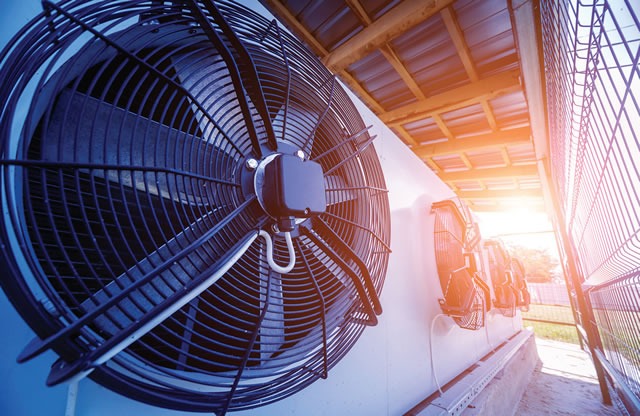Mitigating the Risk of COVID-19 and Improving Indoor Air Quality in Schools
According to the U.S. Government
Accountability Office, 40%
of school districts (representing about
36,000 schools nationwide) need to
update or replace their Heating, Ventilating
and Air Conditioning (HVAC)
systems. In 2020 and 2021, Congress
passed three stimulus bills that provided
nearly $190.5 billion to the Elementary
and Secondary School Emergency Relief
(ESSER) Fund. A significant portion
of the ESSER Fund is earmarked for
schools to undertake HVAC system
maintenance and make the upgrades
necessary to mitigate the spread of
COVID-19 and improve Indoor Air
Quality (IAQ).

PHOTO CREDIT ROMAN ZAIETS
When evaluating options for
maintaining and upgrading an HVAC
system, it is important to follow guidelines
established by the U.S. Centers for
Disease Control and Prevention (CDC).
A key CDC recommendation for HVAC
systems references guidance from the
American Society for Heating, Refrigerating
and Air Conditioning Engineers
(ASHRAE). ASHRAE Standard 62.1
outlines the functions that a well-designed
and maintained HVAC system
should perform to maximize IAQ and
mitigate pathogen risks. These functions
include:
Ventilation
Introducing outdoor air into a building
is critical to ensure proper IAQ, as the
fresh air allows the HVAC system to
purge contaminants (e.g., airborne viruses,
bacteria, volatile organic compounds)
from the building. When introducing
outdoor air into a building to mitigate
the risk of COVID and improve IAQ,
consider one or more of the following:
- Disable demand control ventilation to
maximize the amount of outdoor air
introduced into the space, regardless of
occupancy level.
- Run the HVAC system continuously
to prevent buildup of contaminants.
- Run the HVAC system longer than
normal occupancy mode. Start
delivering fresh air into the space
before occupants arrive and continue
after they leave, providing a pre- and
post-occupancy flush of the air.
Filtration
Increasing air filtration is another tool
to mitigate the risk of COVID and
improve IAQ. HVAC systems typically
utilize filters with a Minimum Efficiency
Reporting Value (MERV) rating of 8.
MERV 8 filters are effective at capturing
large particles, such as dust and pollen,
but are not effective at capturing smaller
pathogens. Filters with a MERV 13 rating
or higher can capture approximately
85% of airborne respiratory particles and
are recommended to help capture SARSCoV-2 and other pathogens.
However, filters with higher MERV
ratings will increase resistance to airflow.
To overcome the resistance of filters with
higher MERV ratings, the ventilation
system’s fans will likely need to run
faster to deliver the proper ventilation
rate. Consult a qualified HVAC engineer
or contractor to ensure fans have the
capacity to run at higher speeds and that
the duct system can support the higher
pressures.
Circulation
Air circulation refers to how air moves
within a space as a function of air
rotations and air velocity. Proper air
circulation reduces high concentrations of
pathogens from forming in a space. Air
circulation also aids in destratification
(mixing hot air that rises with cooler
air beneath) to help improve occupant
comfort and reduce energy costs. High
volume low speed (HVLS) ceiling fans are
ideal for increasing circulation in a space.
Humidification
Studies show that maintaining a relative
humidity of between 40%–60% will
reduce the potential of airborne viral
transmission. Utilizing energy recovery
with a dedicated outdoor air system
(DOAS) will help reduce the cost to
humidify (or dehumidify) ventilation
air. Supplemental humidification and/or dehumidification can be added to
more traditional HVAC systems. Again,
it is wise to consult a qualified HVAC
engineer or contractor to maximize
your system capabilities and minimize
operating costs.
Additive Air Cleaning
Technologies
Air cleaning technologies may also
be added to existing HVAC systems. Popular options include:
- Ultraviolet germicidal irradiation (UVGI): UVGI uses
short-wavelength ultraviolet light to kill or inactivate
microorganisms and can be installed near ceilings or within
HVAC equipment.
- Bipolar ionization (BPI) and needlepoint bipolar ionization
(NBPI): BPI and NBPI produce a stream of ions that attract
viral particles to cling together, improving the effectiveness
of filter systems. Studies regarding the application of BPI and
NBPI to mitigate the risk of pathogens such as SARS-CoV-2
are ongoing.
Importance of Energy Efficiency
HVAC systems typically account for approximately 40% of the
energy usage in commercial buildings. Upgrading an HVAC
system to improve IAQ will likely increase energy consumption.
To minimize HVAC operating costs when incorporating
IAQ upgrades, make sure to comply with the latest guidelines
for ASHRAE 90.1, which provides minimum energy efficiency
requirements for building design and local energy codes.
Recommendations
To maximize the use of ESSER Funds to improve your HVAC
system, consult with an experienced HVAC engineer or contractor
familiar with CDC ventilation guidelines, ASHRAE
Standard 62.1 and ASHRAE 90.1. If new HVAC equipment is
needed, make sure that the manufacturer performance claims
are verified by an independent, third-party, certified ratings
program. Trade associations such as the Air Movement and
Control Association (AMCA) and Air Conditioning Heating
Refrigeration Institute (AHRI) have excellent performance
certification programs in place to ensure that manufacturers’
products perform as specified.
Using ESSER Funds to maximize HVAC system operation,
mitigate the risk of COVID-19 and improve IAQ will ensure
students can safely attend school in a healthy environment that
maximizes their ability to learn.
Recommended sources:
This article originally appeared in the Spring 2021 issue of Spaces4Learning.
About the Author
Mike Wolf, P.E. is the Director of Industry/Regulatory Relations at Greenheck, a manufacturer of air movement, control and conditioning equipment based in Schofield, Wis. He is a professional engineer and ASHRAE member with 35 years of experience in the ventilation industry.